Has your school caught the public eye? More important, has it attracted the attention of prospective students? One route to those goals is advertising, and many seminaries take that road when they can. In this article, Sharon J. Anderson, an experienced ad consultant to religious organizations and others, critiques a half dozen recent seminary ads and suggests ways they could have been better.
If that headline, my opening salvo, captured your attention, I’ve won half of today’s advertising battle. The other half is retaining your attention, a more formidable challenge because your attention span, as an average American consumer, is a precious two seconds. You are, after all, only human. You can take in only a limited amount of information. Beyond a certain point, your brain goes blank. That’s why, of the 30,000 ads (print, video, electronic) that assault your mind every day, you will vaguely notice about eighty and have some sort of reaction to just twelve. Nearly half of all consumers each year cannot think of a single memorable advertisement, according to James B. Twitchell in his book Adcult USA.
The numbness of our consumer age notwithstanding, too much corporate and institutional marketing does not follow today’s Golden Rule: Communicate unto others. Period. To solve the double-whammy challenge of getting your message noticed and getting a response, you need to turn things inside out. Al Ries and Jack Trout write in their marketing classic : “You look for the solution to your [marketing] problem not inside the product, not even inside your own mind. You look Positioning: The Battle for Your Mind: for the solution to your problem inside the prospect’s mind.” In other words, it ain’t about you. It’s about the people you want to serve. Their needs. Their desires. Their dreams. Using images and language they understand.
The Hebrew prophets knew this. “The prophet is engaged in a battle for language,” writes Walter Brueggemann in The Prophetic Imagination, and “he has only the hope that the ache of God could penetrate the numbness of history.” To communicate that ache, that hope concretely, the prophets employed “the language of amazement,” to quote Brueggemann again.
Listen to the prophet Habakkuk, for example, as he exhorts his audience: “Write the vision, make it plain on tablets, so that a runner may read it” (Habakkuk 2:2 New Revised Standard Version). Or as paraphrased less eloquently in the Living Bible, yet more to the communication needs of today’s weary society: “Write my answer on a billboard, large and clear, so that anyone can read it at a glance and rush to tell others.”
Rush to tell others? Why? Because the prospect is on fire. The message has tapped into emotion. We are in the twilight of a society based on data,” says Rolf Jensen in The Dream Society. “As [data and intelligence become the domain of computers, society will place more value on the one human ability that cannot be automated: emotion. Imagination, myth, ritual—the language of emotion—will affect everything.”
Bottom line, a solid marketing message (i.e., one that grabs my attention and retains it for longer than two seconds) must:
Focus on the prospect, not the product.
Employ the language of amazement.
Tap into emotion.
Does a harvest of theological school ads from recent issues of Christianity Today, The Christian Century and National Catholic Reporter meet the above criteria?
I’ve got good news and bad news. The good news is that in the midst of a brutal economic climate that has dramatically diminished many marketing budgets, seminaries are still generously committed to getting their messages out. The bad news is that these messages, for the most part, are murky and bloodless. They don’t stick. They’ve got no legs. Worse, no heart. Even worse, they don’t focus on the prospect.
Predominately members of Generation X, these prospects “are looking for a place to belong,” said James Brownson, academic dean of Western Theological Seminary in Holland, Michigan, in an interview recounted in the Autumn 2002 issue of In Trust. According to Dennis Voskuil, Western’s president, what potential seminarians are looking for is simply “passion and integrity.”
They want to be amazed. They’ve fallen in love with Jesus, and Christ has emblazoned on their hearts his shattering call to serve. Marketing professionals owe them a message aimed precisely at their precious point of need. A message that informs, yes; but more crucially, a message that inspires.
Let’s turn to cases:
Case Study No. 1
Beeson Divinity School
Full page, four color
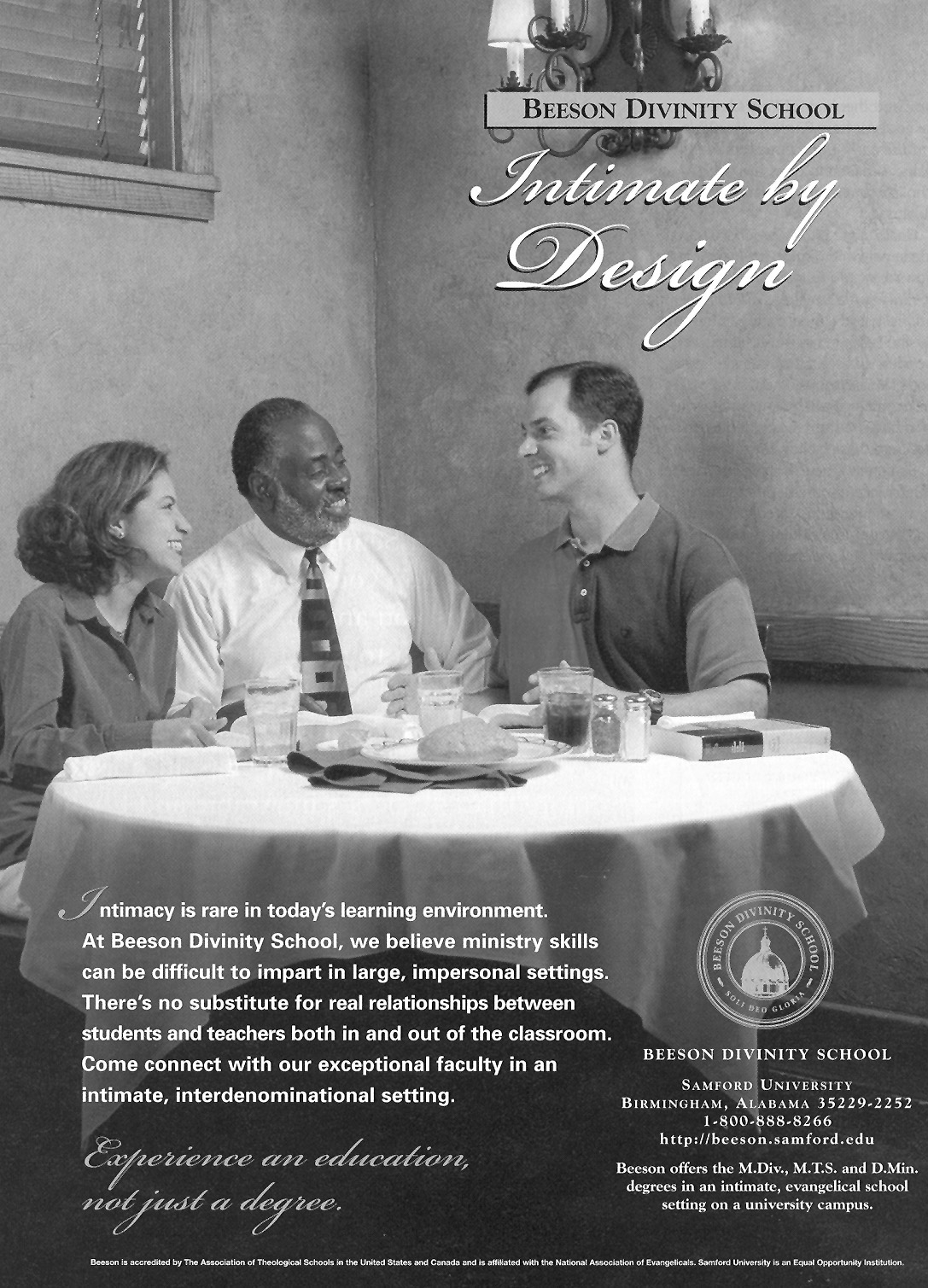
Good News: The seminary can afford a full-page color ad. I pause, perplexed that a restaurant ad is in Christianity Today. I read the headline “Intimate by Design” and realize, No, this isn’t about dining, this is about marital counseling. Or is it? I read the beginning of the body copy: “Intimacy is rare in today’s learning environment.” This is a typical classroom? I then notice “Beeson Divinity School” above the headline. The gold color of that copy box leads my eye to the gold type of the tagline: “Experience an education, not just a degree.”
Bad News: How much will this seminary education cost? Do I have to pay for the white table cloths in this fancy-shmancy student dining room? Or maybe this is the faculty dining room. They have a separate dining room? I have to go to them for an intimate connection? They won’t come to me? I’m outta here.
Better:
Headline:
Stay connected.
To God. To others. To yourself.
Image:
[Same folks, perhaps relaxing in the back of a classroom.]
Body copy:
Get a life, not just a degree. There’s no substitute for real relationships between divinity
students and faculty.Come connect with our exceptional
Beeson Divinity School Samford University
1-800-888-8266
http://beeson.samford.edu
|
Case Study No. 2
Denver Seminary
1/2 page, full color
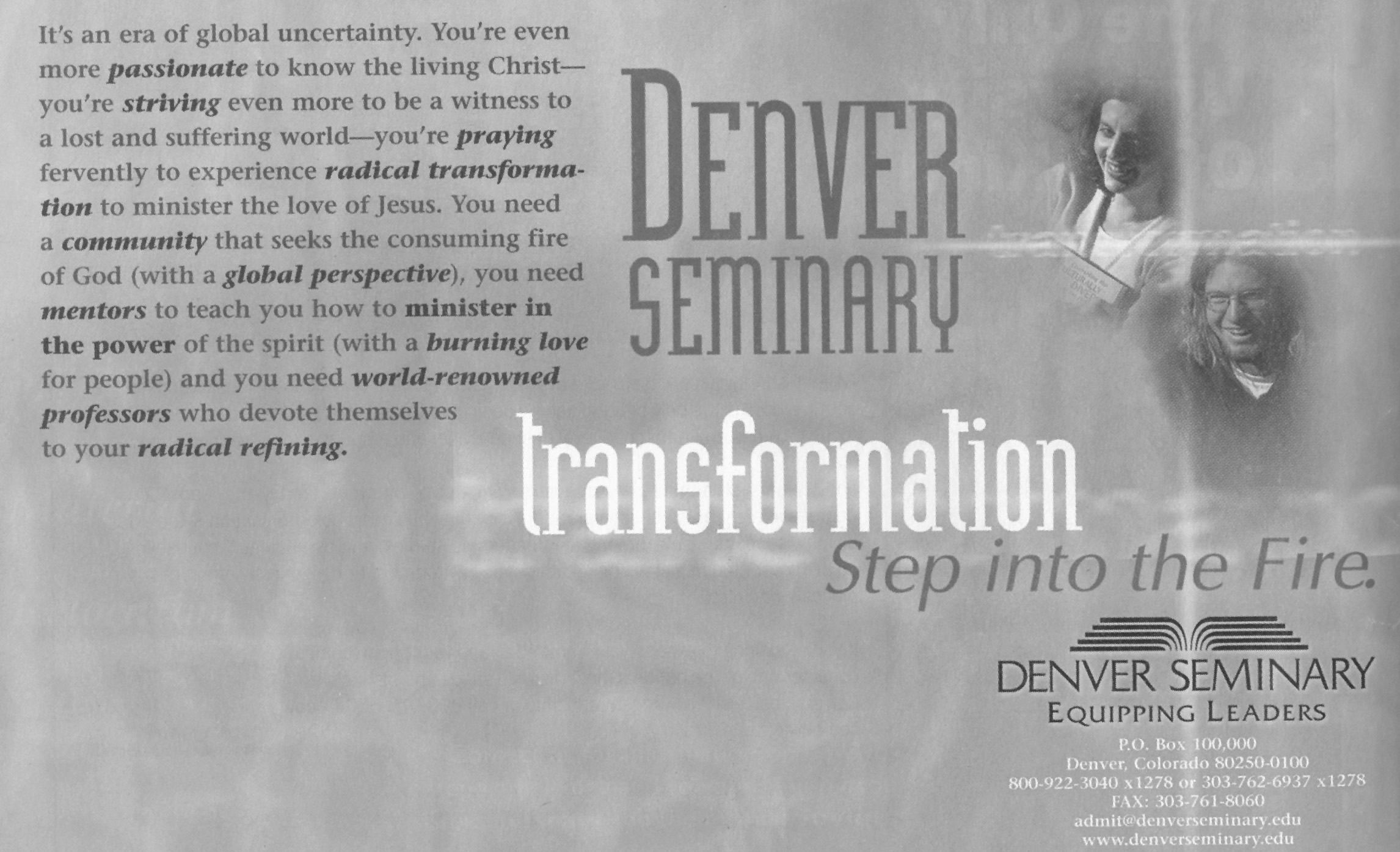
Good News: The dramatic orange color that can’t be shown on this page catches my eye. I first notice the words: “Denver Seminary.” Then I see small images of Gen-X prospects (male has grunge look). I trip over the big, multi-syllabic word “transformation.” I’m intrigued by the exhortation: “Step into the Fire.”
Bad News: I first notice the words "Denver Seminary” rather than “Step into the Fire,” the words that really yank my Jesus chain. I vaguely notice the word “passionate” rendered in bold type in the body copy, and get mired in “radical transformation” and “global perspective”and “world-renowned professors,” also bold, and my eyes glaze over. I’m outta here. Besides, I can’t easily read how to respond because that particular information is in tiny, reverse white type in the bottom, right-hand corner.
Better:
Headline:
Step into the Fire
Image:
[Larger photos of hip Gen-X types]
Body copy:
Denver Seminary
Equipping Leaders
1-800-922-3040
www.denverseminary.edu
|
Case Study No. 3
Aquinas Institute of Theology
7x5, black and white
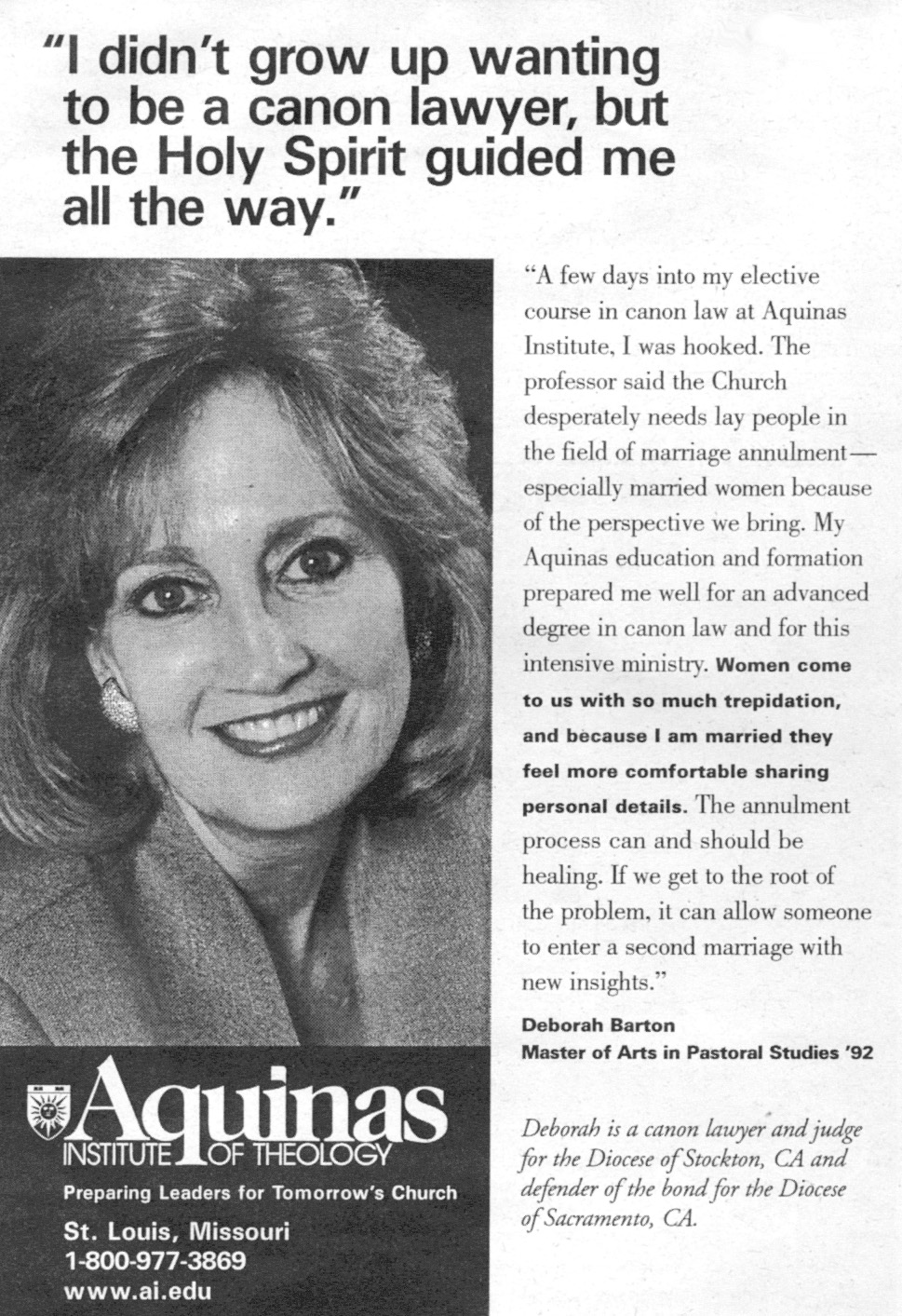
Good News: The headline is so brazen, my jaw drops open. You’ve got my attention. I note as well that the image says the seminary is reaching out to women. Kudos.
Bad News: Call me cynical, but I can’t conceive that anyone actually uttered the words in the headline. Also, call me confused. Is this an ad for legal services or for theological education? The woman quoted in the body copy, an Aquinas graduate, is now a canon lawyer and judge for a Catholic diocese. I want to believe her pastoral sincerity, but the overriding opportunistic tone of the ad unfairly implies that she is an ambulance-chaser.
Better:
Headline:
Aquinas Institute of Theology:
Our name says volumes.
We’ll help your name say volumes, too.
Image:
[Same]
Body copy:
“A few days into my elective course in canon law at Aquinas Institute, I was hooked. The professor said the Church desperately needs lay people in the field of marriage annulment— especially married women because of the perspective we bring. I have found it so. Women come to us with so much trepidation, and because I am married, they feel more comfortable sharing personal details. In school I learned the annulment process can and should be healing. I was needed. Aquinas showed me the way.”
[Student name]
Master of Arts in Pastoral Studies ‘92
Aquinas Institute of Theology
Make a name for yourself.
1-800-977-3869
www.au.edu
Deborah is a canon lawyer for the Diocese of Stockton, CA, and defender of the bond for the Diocese of Sacramento, CA. |
Case Study No. 4
Dubuque Theological Seminary
4x4 1/2, black and white
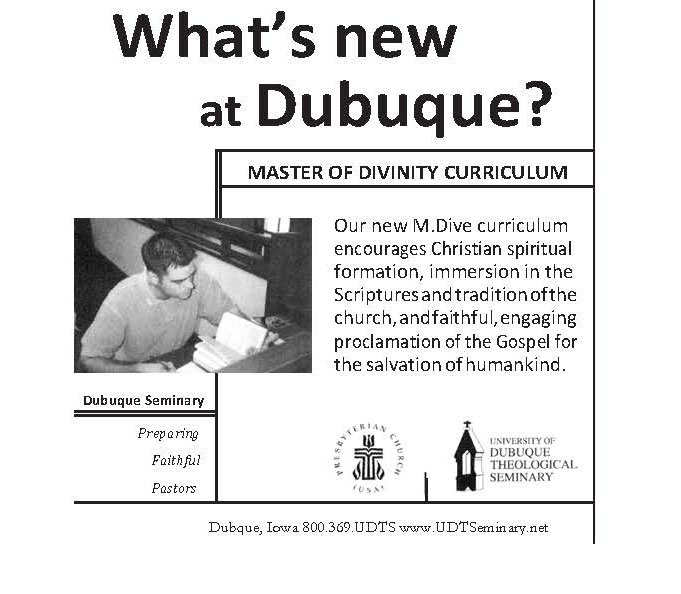
Good News: The headline gets straight to the point: “What’s new at Dubuque?” I’m pulled in by the “u” assonance (and the implied “you”). The answer: “Master of Divinity Curriculum.” I notice “humankind,” not “mankind,” in the body copy. I vaguely notice the small image of a student, properly attentive to the new curriculum.
Bad News: What’s new? Maybe the curriculum, but not how it prepares me to a faithful pastor. Looks like a drag.
Better:
Headline:
What’s new at Dubuque?
More for you.
Master of Divinity
Curriculum
Image:
[Larger image of a more vibrant student, looking
right at me. Call Colgate Rochester Crozer Divinity School; see if Tim has a sister.]
Body copy:
Our new M.Div. curriculum encourages you to become who you were called to be: a servant fully engaged in proclaiming the Gospel to a world that needs you.
University of Dubuque Theological Seminary
We’re all about you.
1-800-369-UDTS,
www.UDTSeminary.net |
Case Study No. 5
School of Applied Technology
5x5, black and white
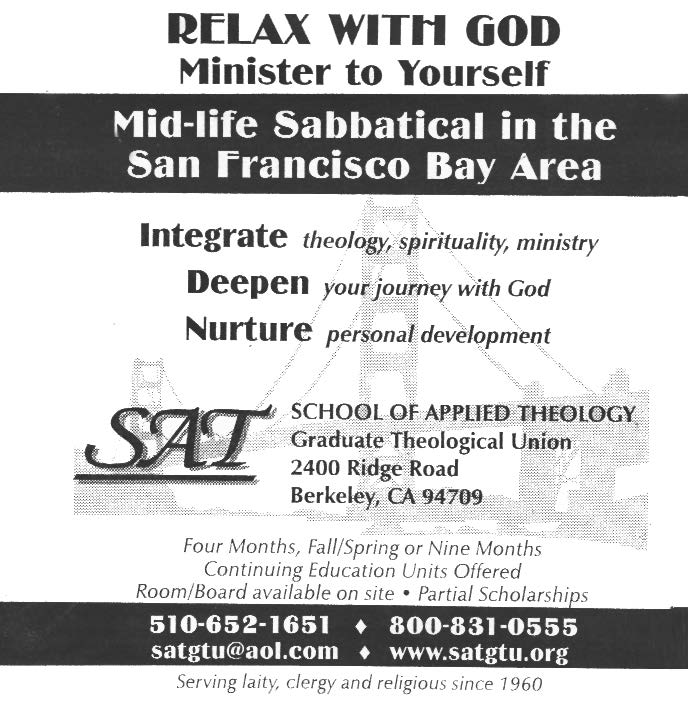
Good News: I’m beat. I work too hard. I need a break.I need to “Relax with God.” Minister to myself. So why this bridge image and not a hot tub? Oh, I’m relaxing at Berkeley. In San Francisco. That explains everything. I’m with ya, dude. Sign me up.
Bad News: You say I’ll relax, but based on all this copy and I don’t know what to focus on and there’s just too many words and the kids are yelling and the dog’s at the vet and someone stole my Bible...I’m outta here.
Better:
Headline:
[Type reversed on black]
Mid-life Crisis? Get serious. Relax. With God.
Image:
[None.]
Body copy:
Can’t take it any more? Take care.
Invest in a mid-life sabbatical in the San Francisco area. Deepen your journey with God and learn some new things along the way.
School of Applied Theology
Graduate Theological Union
1-800-831-0555
www.satgtu.org |
Case Study No. 6
Colgate Rochester Crozer Divinity School
4 1/2 x 7 1/2, black and white
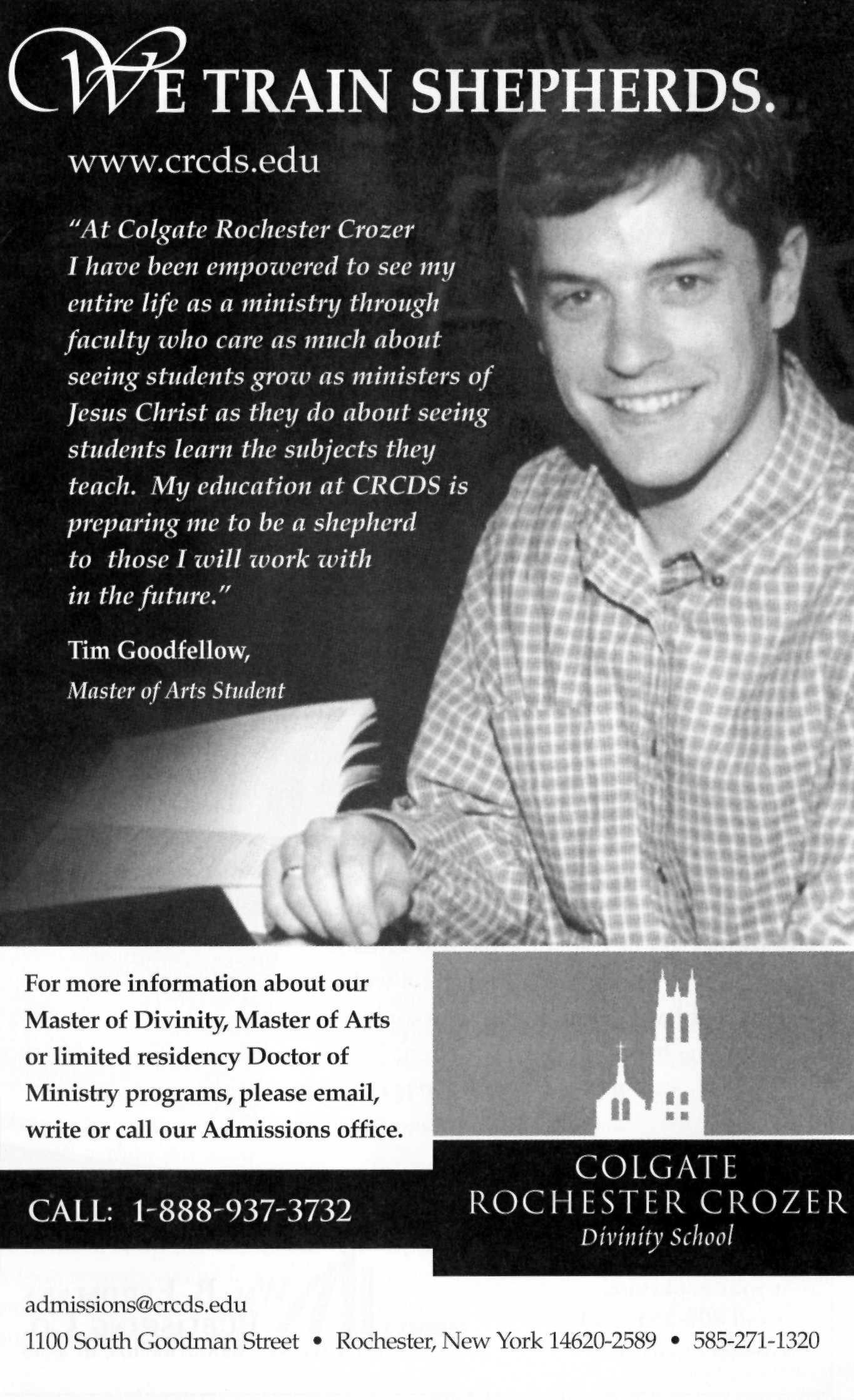
Good News: The Gen-Xer is cute, seems genuine, not a stock photo. He’s a real human being looking right at me. The headline tells me he’s a shepherd in training. Cool. Right beneath the headline is the seminary URL. I notice the shepherd’s name, “Tim Goodfellow.” Contrived? I buy it, because Tim’s looking right at me. Tell me more, Tim.
Bad News: What Tim has to say to me in the body copy seems a bit too polished.You had me with the look, but you’re losing me with the hype. Get to the point, please, because I’ve already invested about six seconds of my time. You’re looking at me, Tim, but you’re not saying what I need to hear.
Better:
Headline:
We Train Shepherds.
www.crds.edu
Image:
[We’re loving Tim.]
Body copy:
“My name is Tim, but call me
empowered, thanks to faculty
members who care as much about
me as the subjects they teach.
They’ll care about you, too.”
Are you a shepherd?
Call 1-888-937-3732
Colgate Rochester Crozer Divinity School |
So those are my six cases. What do the ads or my commentary on them have to do with the governing boards of theological schools? Advertising the school is a responsibility of the administration, isn’t it? True enough, but governing boards and their members bear special responsibility for understanding, developing, and furthering the propagation of their institution’s message to the world. Boards and board members are “message-keepers,” stewards not only of the Word, but also potentially stewards of the words in ads, brochures,web sites—any medium used to convey how the Word is taught, proclaimed and sent forth from their institution.
Resources
Sharon Anderson recommends these two books:
The Prophetic Imagination, by Walter Brueggemann (Fortress Press, 2001).
Positioning: The Battle for your Mind, by Al Ries and Jack Trout (McGraw-Hill, 2001).
Editor's Note: If your school is interested in working with Sharon J. Anderson on an advertising project, you can reach her by email at sharon.j.anderson@verizon.net.